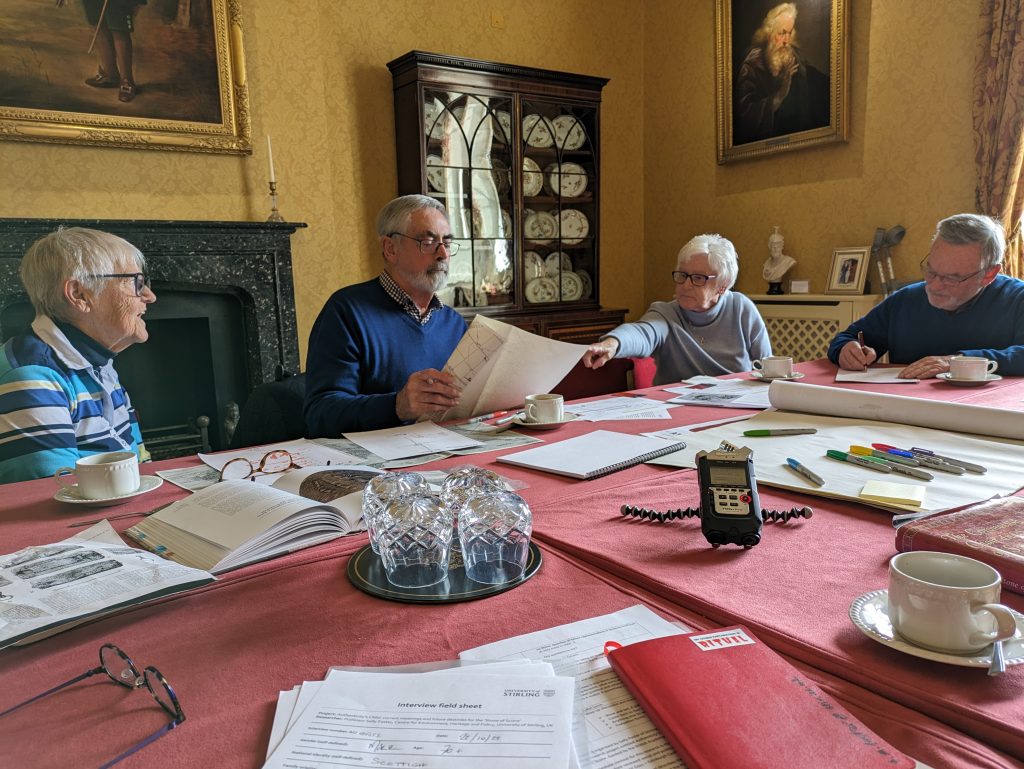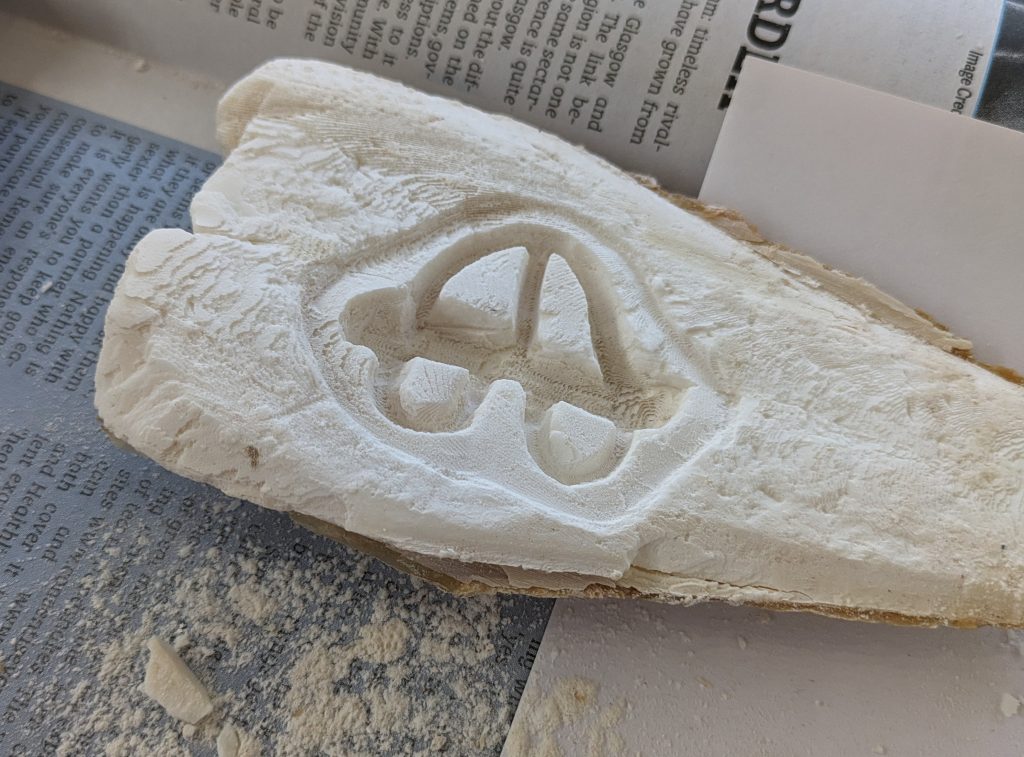
Bonkers but brilliant is how I would need to describe my last, six-day week. It included four days of ethnographic work in different places and with high varied subjects and methodologies: semi-structured interviews, short interviews, participant observation and two different workshops. That’s the bonkers bit – don’t try this every week! But the brilliant bit was the pleasure of the work – meeting so many engaged, thoughtful, constructive and nice people – and the value of what I learnt from them. For now, let me share a bit more about what I did and end with some of their observations.



On Monday, Scone Palace introduced me to four Friends of Scone Palace, locals well known to them because they visit the Palace several times a week. These friends could offer perspectives on the contemporary lived landscape around where the Stone was used to inaugurate Scottish kings in the second half of the thirteenth century. This is a much transformed place; the community of Old Scone was moved to (New) Scone in the early nineteenth century to improve the amenity of the redesigned Palace. Stephen Brannigan and his team treated us royally, with use of the sumptuous Murray Room and excellent catering. These F/friends had the bonus of seeing a bit of the behind-the-scenes at the Palace.


I also interviewed a Palace guide for their own fascinating perspective and what they learn from observing visitors. What a view we had during that talk!
On Friday, I was in Edinburgh Castle, again learning from the keen observations of guides at heritage sites. Standing with Castle Guides in the Crown Room, behind the ropes, I observed visitors interacting with the Stone and Regalia and asking questions. It was noticeable how curious children can be, particularly about the rings on the Stone.

Visitors (and researchers!) cannot take pictures in the Crown Room, but note the queues outside to get in.

Note also the sign about my research, one of several strategically placed for visitors’ attention. I asked visitors questions about their experience of the Stone in the splendid Laich Hall, as they left the royal apartments.
I owe Nicki Scott and Guiding Manager Nigel Nairne, and his team, an enormous thanks for enabling my ongoing work at Edinburgh Castle.
By train again to Edinburgh on Tuesday, I entered unfamiliar territory to interview the Lord Lyon at the Court of the Lord Lyon. The Lord Lyon led on the creation of new rituals to accompany the movement of the Stone from Edinburgh Castle to Westminster Abbey for the 6 June 2023 Coronation, and during the 6 May Service of Thanksgiving for Charles II and Queen Camilla in St Giles’, Edinburgh. Thank you Joe Morrow, and Ceremonial and Development Officer, Fiona Mackay.

On Saturday, I had the pleasure to meet and work with Perth Women’s Collective here at Stirling, in our Pathfoot Building. This workshop was co-organised with our Art Collection and Dr Mark Hall of Perth Museum. Becca McClune of Gender Equality Perth did a super job in supporting this event and organising everyone. A picture says a thousand words (see below), but you should know that we were considering where women feature, or could feature, in the Stone story and its future. Mark and I provided an introduction to the Stone’s life, which mentioned the presence / absence of women in its myths and history. Then:



Perth Museum’s copy of the Stone was only on its second public outing, so this is probably the first time it has been sat upon.
But the highlight of the event was that everyone was taught how to make a pewter cast by Emma, inspired in some way by how we feel about the Stone. This short exercise was extremely effective in eliciting ways in which individuals were feeling or starting to feel about the Stone and its future (see a selection of quotes below).





‘I had a women’s symbol right over the middle of the Stone because […] I just felt we now have an opportunity to start again and redefine it again and that women could actually do something more with this Stone, now that it has come back here and now that we have such a strong Collective.’
‘I did it with a back-to-front K, to commemorate Kay [it’s all back-to-front the story, isn’t it, because she wasn’t given the recognition]. Her story resonated with me. I didn’t really know her story. A spoon because all these spoons are in there [Sally’s collection] commemorating something but nobody really knows initially her story. Even from the newspaper her story was presented as she was just a kind of handy person to drive a car as opposed to somebody who it actually meant something to her. I felt like maybe we should make a nod to Kay […] She has a place in the story.’
‘Mine is the getaway car that Kay drove because I found that the most interesting bit of what we talked about today.’
‘I made a commemorative medal, just with the Stone on, which was meant to reference the branding of the new museum […] And then there’s a D on the Stone for Destiny, which is actually a reference to a contemporary pop song […] and I thought it was quite funny that you tweak this to say ‘I went to Scone and got the Big D’, a vague reference to how it was moved or where it was from.’
‘I made this one emphasising the handles on the Stone because that it’s how it gets moved around and I just think that the journeys of the Stone and the movements of the Stone from Scotland to England, and England back to Scotland, and the theft, and the movement to Perth is so much of the story and contemporary thought and views around it are linked to its journeys and its movement. And I made it as pendant as a nod to the jewellery that was made from the Stone.’
Both this week’s workshops worked particularly well because they were with people already established as a group. They came as their own ready ‘safe space’, ready to discuss among themselves and game to disagree. They turned up, they were keen, and in these circumstances half-day workshops spanning a lunch can achieve a lot in a short time, if carefully designed. We are also, I realise, testing ways of working with the Stone that may have a role in future outreach and educational activities around the Stone. As three of our Perth Women’s Collective participants commented as our workshop drew to a close:
‘It is interesting that it can be something that brings people together and promotes dialogue.’
‘But what you’re going round all these different groups is doing that. School children, and us, and various groups are all thinking, yeah right enough. We’re rethinking some.’
‘I think it’s a key thing for museums in general going forward, is welcoming people’s responses and the stories people build around things as having equal merit to the official “history”, of known facts around things, they obviously have a place, but the responses people bring to things, it is a challenge in the context of what we traditionally know as a museum. For lots of reasons, not least funding and resources, you can’t have a display that is constantly changing but you do have to find a way to open the interpretation to be constantly evolving. An object like this stone is a very solid static thing but the dialogues around it about nationalism, about the monarchy are ever changing and evolving. The challenge for museums is how do you have that evolving dialogue around it and invite those responses. The obvious easier way a lot of times is digital but personally I don’t like digital, although it has it place… I think a lot of it is around this type of programming, inviting people into a space to share what they feel.’
Queries or further information: Professor Sally Foster. Full project website: https:\\thestone.stir.ac.uk.
All images (c) Sally Foster unless stated.
Funded by:

